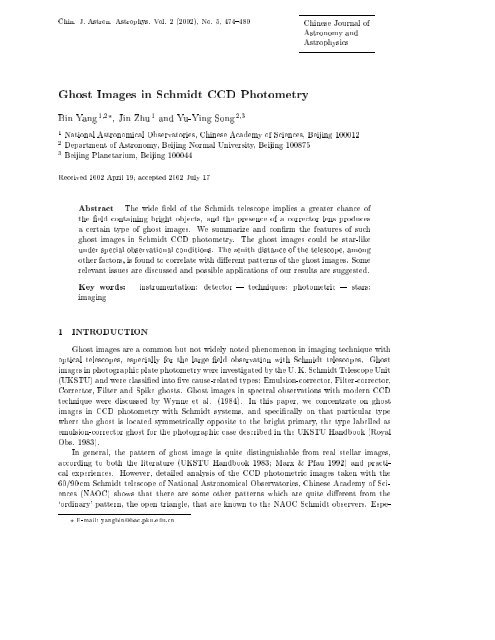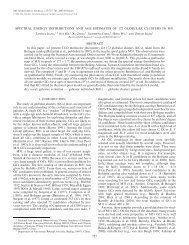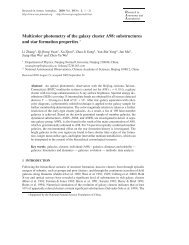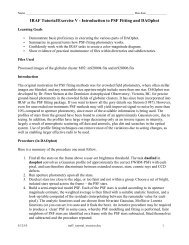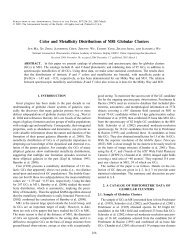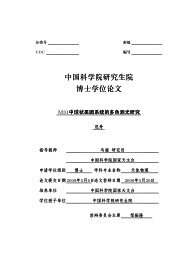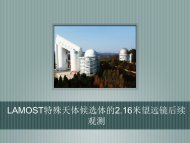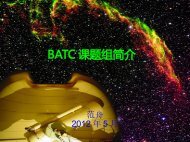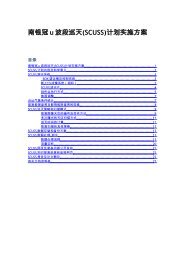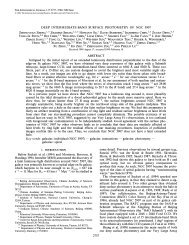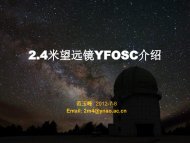Ghost Images in Schmidt CCD Photometry - BATC home page
Ghost Images in Schmidt CCD Photometry - BATC home page
Ghost Images in Schmidt CCD Photometry - BATC home page
You also want an ePaper? Increase the reach of your titles
YUMPU automatically turns print PDFs into web optimized ePapers that Google loves.
Ch<strong>in</strong>. J. Astron. Astrophys. Vol. 2 (2002), No. 5, 474{480Ch<strong>in</strong>ese Journal ofAstronomy andAstrophysics<strong>Ghost</strong> <strong>Images</strong> <strong>in</strong> <strong>Schmidt</strong> <strong>CCD</strong> <strong>Photometry</strong>B<strong>in</strong> Yang 12? , J<strong>in</strong> Zhu 1 and Yu-Y<strong>in</strong>g Song 231 National Astronomical Observatories, Ch<strong>in</strong>ese Academy of Sciences, Beij<strong>in</strong>g 1000122 Department of Astronomy, Beij<strong>in</strong>g Normal University, Beij<strong>in</strong>g 1008753 Beij<strong>in</strong>g Planetarium, Beij<strong>in</strong>g 100044Received 2002 April 19 accepted 2002 July 17Abstract The wide eld of the <strong>Schmidt</strong> telescope implies a greater chance ofthe eld conta<strong>in</strong><strong>in</strong>g bright objects, and the presence of a corrector lens producesa certa<strong>in</strong> type of ghost images. We summarize and conrm the features of suchghost images <strong>in</strong> <strong>Schmidt</strong> <strong>CCD</strong> photometry. The ghost images could be star-likeunder special observational conditions. The zenith distance of the telescope, amongother factors, is found to correlate with dierent patterns of the ghost images. Somerelevant issues are discussed and possible applications of our results are suggested.Key words:imag<strong>in</strong>g<strong>in</strong>strumentation: detector | techniques: photometric | stars:1 INTRODUCTION<strong>Ghost</strong> images are a common but not widely noted phenomenon <strong>in</strong> imag<strong>in</strong>g technique withoptical telescopes, especially for the large eld observation with <strong>Schmidt</strong> telescopes. <strong>Ghost</strong>images <strong>in</strong> photographic plate photometry were <strong>in</strong>vestigated by the U. K. <strong>Schmidt</strong> Telescope Unit(UKSTU) and were classied <strong>in</strong>to ve cause-related types: Emulsion-corrector, Filter-corrector,Corrector, Filter and Spike ghosts. <strong>Ghost</strong> images <strong>in</strong> spectral observations with modern <strong>CCD</strong>technique were discussed by Wynne et al. (1984). In this paper, we concentrate on ghostimages <strong>in</strong> <strong>CCD</strong> photometry with <strong>Schmidt</strong> systems, and specically on that particular typewhere the ghost is located symmetrically opposite to the bright primary,thetype labelled asemulsion-corrector ghost for the photographic case described <strong>in</strong> the UKSTU Handbook (RoyalObs. 1983).In general, the pattern of ghost image is quite dist<strong>in</strong>guishable from real stellar images,accord<strong>in</strong>g to both the literature (UKSTU Handbook 1983 Marx & Pfau 1992) and practicalexperiences. However, detailed analysis of the <strong>CCD</strong> photometric images taken with the60/90 cm <strong>Schmidt</strong> telescope of National Astronomical Observatories, Ch<strong>in</strong>ese Academy ofSciences(NAOC) shows that there are some other patterns which are quite dierent from the`ord<strong>in</strong>ary' pattern, the open triangle, that are known to the NAOC <strong>Schmidt</strong> observers. Espe-? E-mail: yangb<strong>in</strong>@bac.pku.edu.cn
<strong>Ghost</strong> <strong>Images</strong> <strong>in</strong> <strong>Schmidt</strong> <strong>CCD</strong> <strong>Photometry</strong> 475cially, some ghost images could be of the same pattern as stellar images under certa<strong>in</strong> observ<strong>in</strong>gconditions. Ignorance of the existence of ghost images may lead to false detections of opticaltransients (OTs), such as optical afterglows of gamma-ray bursts, splitt<strong>in</strong>gs of comets, asteroids,comets, or supernovae etc.All the observations mentioned <strong>in</strong> this paper were made with the NAOC 60/90 cm <strong>Schmidt</strong>telescope plus a 2048 2048 <strong>CCD</strong> (Chen 1998).2 FEATURES AND CONFORMATIONS OF GHOST IMAGES2.1 Features of <strong>Ghost</strong> <strong>Images</strong>A quite obvious characteristic of ghost images is that a ghost image and its bright primaryare centrally symmetric about a xed po<strong>in</strong>t, near the center of the <strong>CCD</strong> frame. Explanationof this phenomenon could parallel the explanation for the case of photographic photometrydescribed <strong>in</strong> the UKSTU Handbook (Royal Obs. 1983), that is, the light form<strong>in</strong>g the primaryimage is reected at the <strong>CCD</strong> to the ma<strong>in</strong> mirror, then reect<strong>in</strong>g at the mirror to correctorlens, where it is partially back-reected to the ma<strong>in</strong> mirror aga<strong>in</strong>. F<strong>in</strong>ally, the ma<strong>in</strong> mirrorreects it back down onto the <strong>CCD</strong> to form the ghost image. Therefore, the ghost imageand its primary image are symmetric with respect to the optical axis accord<strong>in</strong>g to the law ofreection. The center of symmetry corresponds to the <strong>in</strong>tersection of the opticalaxisonthe<strong>CCD</strong> surface, which may not co<strong>in</strong>cide with its physical center. For the 2048 2048 <strong>CCD</strong> onthe NAOC <strong>Schmidt</strong> system, the center of symmetry is found to be at at (1013 1, 980 3),from statistics of observations made <strong>in</strong> November 1999. We may expect this position will notchange unless the optical system undergoes adjustment (such as coat<strong>in</strong>g of the ma<strong>in</strong> mirror).The ghost image is about 7 to 8 magnitude fa<strong>in</strong>ter than the primary image but the magnitudedierence is not l<strong>in</strong>ear with the brightness of the primary, seeTable 1. Therefore, ghostimages are only visible for the brightest stars and/or under long exposures. The magnitudes ofthe primary stars are taken from USNO-A2.0 Catalogue (Monet et al. 1998) directly, whilethemagnitudes of the ghost images are obta<strong>in</strong>ed with aperture photometry adopt<strong>in</strong>g magnitudesof reference stars from the same catalogue. The error for the derived m could be greater than0.5 mag.Table 1Magnitude of <strong>Ghost</strong> Image and Its Primarym prim:st: 3.6 5.6 6.2 6.8 7.4 8.3 8.8 10.4 10.9m ghos:im: 10.6 13.4 13.1 13.7 14.8 15.5 16.3 17.3 18.3m 7.0 7.8 6.9 6.9 7.4 7.2 7.5 6.9 7.4The <strong>CCD</strong> images also show thatvery bright stars are often accompanied by aureole (correctorghost and halo as described <strong>in</strong> the UKSTU handbook (Royal Obs. 1983)), and thereare also aureoles around ghost images too. The brighter the star is, the more dist<strong>in</strong>ct is theaureole. The ghost image aureoles are concentric, usually with three sharp boundaries at radii1.65 mm, 4.32 mm and 5.48 mm from the image center.2.2 Classication of <strong>Ghost</strong> Image Conformations<strong>Ghost</strong> images appear <strong>in</strong> dierent shapes under dierent conditions (airmass, see<strong>in</strong>g, focusdistance etc.), and can be divided <strong>in</strong>to the follow<strong>in</strong>g four types (Fig. 1):
476 B. Yang, J. Zhu & Y. Y. Song,a. Open triangle, which is the most common pattern and is well-known to the NAOC <strong>Schmidt</strong>observers. The triangle deforms slightly with chang<strong>in</strong>g observ<strong>in</strong>g conditions.b. Trifurcate, which can be further divided <strong>in</strong>to sub-types, trifolium, trifoliate w<strong>in</strong>dmill, andso on.c. Solid triangle.d. Po<strong>in</strong>t source, which looks exactly the same as a stellar image and cannot be superciallydist<strong>in</strong>guished from the latter (Fig. 2). In practice, observers could easily mis<strong>in</strong>terpret thisk<strong>in</strong>d of ghost images as real objects.Fig. 1 Classication of ghost image conformations. Open triangle upper-left, Trifurcateupper-right, Solid triangle lower-left, Po<strong>in</strong>t source lower-right.
478 B. Yang, J. Zhu & Y. Y. Song,is that of a trident, or sometime an open triangle, and this is so even under very poor see<strong>in</strong>gcondition. There is a transition from the trident to a solid triangle when the airmass 2. Asthe airmass <strong>in</strong>creases, the three \prongs" get shorter and shorter, to become a typical trianglewhen the airmass approaches 3. The image then changes gradually from a solid triangle toa round po<strong>in</strong>t as the telescope po<strong>in</strong>ts still lower (3 < airmass < 4). After airmass > 4 theghost rema<strong>in</strong>s round however, it can still be dist<strong>in</strong>guished from a real star because its shapeis slightly irregular. Eventually, when the telescope po<strong>in</strong>ts to near horizon (airmass > 5), theghost appears as a regular roundish dot, rema<strong>in</strong><strong>in</strong>g <strong>in</strong>dist<strong>in</strong>guishable from nearby stellar images.Fig. 3Out-of-Focus <strong>Ghost</strong> images.3.4 <strong>CCD</strong> at an Out-of-focus PositionWhen the po<strong>in</strong>t<strong>in</strong>g of telescope is not too low, ghost images assume the most commonshape of open triangle when the <strong>CCD</strong> is at the normal focus and the distance between <strong>CCD</strong>
<strong>Ghost</strong> <strong>Images</strong> <strong>in</strong> <strong>Schmidt</strong> <strong>CCD</strong> <strong>Photometry</strong> 479and the ma<strong>in</strong> mirror is 118.3 cm. Mov<strong>in</strong>g the <strong>CCD</strong> backward and forward along the optical axisproduces out-of-focus images, and alters the shape of the ghost images completely (Fig. 3).As the <strong>CCD</strong>-focus distance <strong>in</strong>creases from 118.30 cm to 119.00 cm, the shape of ghost imagechanges from open triangle to trifurcate, then to po<strong>in</strong>t source. Near 118.55 cm, the ghost imagelooks exactly like a real star. Increas<strong>in</strong>g the distance further changes the shape cont<strong>in</strong>uouslyto solid triangle. When the distance is larger than 118.95 cm, the ghost image reta<strong>in</strong>s its shapebut becomes blurred. All the four types behave <strong>in</strong>thisway. When we decrease the <strong>CCD</strong>-Focusdistance, the ghost rema<strong>in</strong>s <strong>in</strong> the shape of a triangle, but after 118.16 cm it becomes blurredand <strong>in</strong>dist<strong>in</strong>ct.4 DISCUSSION4.1 Shape of <strong>Ghost</strong> Image4.1.1 Trigonal shape of ghost imageWe liketopo<strong>in</strong>t out that the NAOC <strong>Schmidt</strong> corrector lens is xed by three bolts, located<strong>in</strong> an equilateral triangle. A possible explanation of the trigonal shape of the ghost image, wesuspect, is that the corrector lens must sag under gravity at certa<strong>in</strong> zenith distance, and the t<strong>in</strong>ydistortion of the corrector lens then produces out-of-focus ghost images with shapes that areconsistent with the support structure of the corrector lens. S<strong>in</strong>ce the light form<strong>in</strong>g the ghost<strong>in</strong>volves an additional reection <strong>in</strong> the corrector lens, any distortion <strong>in</strong> the corrector aectsmore the ghost than the primary, hence the ghost may appear irregular when the primary stillappears normal.4.1.2 Star-like ghost imageAs stated <strong>in</strong> Section 3.4, the various shapes of the ghost image are related to the extentthe image is out of focus. Consider<strong>in</strong>g that the ghost image is formed dierently from thereal stellar image, the focus for the ghost should deviate from the focus of the system. Nowthe corrector lens is designed to elim<strong>in</strong>ate the aberrations at the system focus, especially forparallel rays, so an out-of-focus ghost image cannot be improved by the corrector lens, henceits irregular shape. If we adjust the position of the <strong>CCD</strong> plate to the focus for the ghost image,then the latter will be star-like. In Section 3.3, it was noted that the ghost appears star-likewhen the telescope po<strong>in</strong>ts at large zenith distance, for then the corrector lens is almost verticaland so does not sag, and the ghost image focuses on the image plate.4.2 Shape of Real Star ImageIt should be noted that the image of a real stellar object changes greatly from a clear imageto a diuse one when the distance between the <strong>CCD</strong> and ma<strong>in</strong> mirror is varied. But the changeis totally dierent from the case of the ghost image discussed <strong>in</strong> Section 3.3. Unlike the ghostimage, the shape of the real star image is not changed when the telescope po<strong>in</strong>ts <strong>in</strong> dierentdirections.4.3 Relevant Problems with <strong>CCD</strong> <strong>Photometry</strong>When a new object or a new feature is found <strong>in</strong> a <strong>CCD</strong> observation, it is preferable to rstexclude the possibility of it be<strong>in</strong>g a ghost image. This can easily be achieved by look<strong>in</strong>g at theopposite position on the other side of the center of the eld to see whether there is a brightobject there.
480 B. Yang, J. Zhu & Y. Y. Song,Toavoid ambiguity,we should take at least two exposures of the same eld with the telescopeshifted slightly between the exposures: any ghost image will then be shifted <strong>in</strong> the oppositedirection to the real images. For reliable detection of mov<strong>in</strong>g objects like asteroids and comets,it is necessary to take at least three exposures of the same eld, and it is then useful to movethe telescope not <strong>in</strong> the same straight l<strong>in</strong>ebetween the exposures, so that we can dist<strong>in</strong>guishghosts from bad pixels easily. Divid<strong>in</strong>g one long exposure <strong>in</strong>to three shorter ones is also helpfulfor cosmic-ray rejection and trac<strong>in</strong>g, though it <strong>in</strong>creases the <strong>in</strong>uence of read-out noise.It is quite useful, especially <strong>in</strong> the case of photometry, tokeep <strong>in</strong> m<strong>in</strong>d of the <strong>in</strong>uence ofghost images when choos<strong>in</strong>g the center of the observation eld. We should avoid choos<strong>in</strong>g theeld center <strong>in</strong> the middle of a bright object or a target, or putt<strong>in</strong>g a bright target <strong>in</strong> the middleof the eld.4.4 Suggestions for Possible Applications4.4.1 Location of optical axisBy measur<strong>in</strong>g the coord<strong>in</strong>ates of both the ghost images and their primaries, we can determ<strong>in</strong>eprecisely the position of optical axis on the <strong>CCD</strong> surface. Repeat<strong>in</strong>g this procedure fromtime to time monitors any change <strong>in</strong> time of the CDD-optical axis separation.4.4.2 Reectivity of ma<strong>in</strong> mirrorFrom the account <strong>in</strong> Section 2.1, it can be seen that the <strong>in</strong>tensity ratio of the ghost and itsprimary depends on the square of the reectivities of the ma<strong>in</strong> mirror and the corrector lens,and on the square of the transmissivity of<strong>CCD</strong> quartz w<strong>in</strong>dow. If we assumethatboth thereectivity of corrector lens and the transmissivity of quartz w<strong>in</strong>dow of <strong>CCD</strong> are constant, thenany timevariation of the reectivity of the ma<strong>in</strong> mirror (which may be caused by the decay ofsurface coat<strong>in</strong>g) can be monitored by a cont<strong>in</strong>ual measurement of the ghost/primary <strong>in</strong>tensityratio.Acknowledgements The authors thank Prof. J. S. Chen, Prof. H. J. Su, Dr. X. J. Jiang,Dr. X. Zhou and Dr. H. Wu for their valuable discussions. They specially acknowledge Dr. R.Cannon for his valuable comments and Dr. Tao Kiang for careful revision on the manuscript ofthis paper. The work is partially supported by the Ch<strong>in</strong>ese National Natural Science Foundationunder the grant No. 10073012. The operation of the NAOC <strong>Schmidt</strong> telescope is supported bythe Ch<strong>in</strong>ese Academy of Sciences and the Ch<strong>in</strong>ese National Natural Science Foundation underthe grant No. 19833020.ReferencesChen J. S., 1998, In: McLean B. J. et al., eds., Proc. IAU Symp. 179, New Horizons from Multi-Wavelength Sky Surveys., Baltimore: Kluwer, 123Fan X., Burste<strong>in</strong> D., Chen J.-S. et al., 1996, AJ, 112, 628Marx S., Pfau W., 1992, AstrophotographyWiththe<strong>Schmidt</strong> Telescope, Cambridge: Cambridge Univ.PressMonet D., Bird A., Canzian B. et al., 1998, USNO-A2.0, Wash<strong>in</strong>gton: US Nav. Obs.UKSTU Handbook, 1983, Royal Observatory, Ed<strong>in</strong>burghWynne C. G., Worswick S.P., LowneC.M.,Forden P. R., 1984, Observatory, 104,23Zheng Z. Y., Shang Z. H., Su H. J. et al., 1999, AJ, 117, 2757


